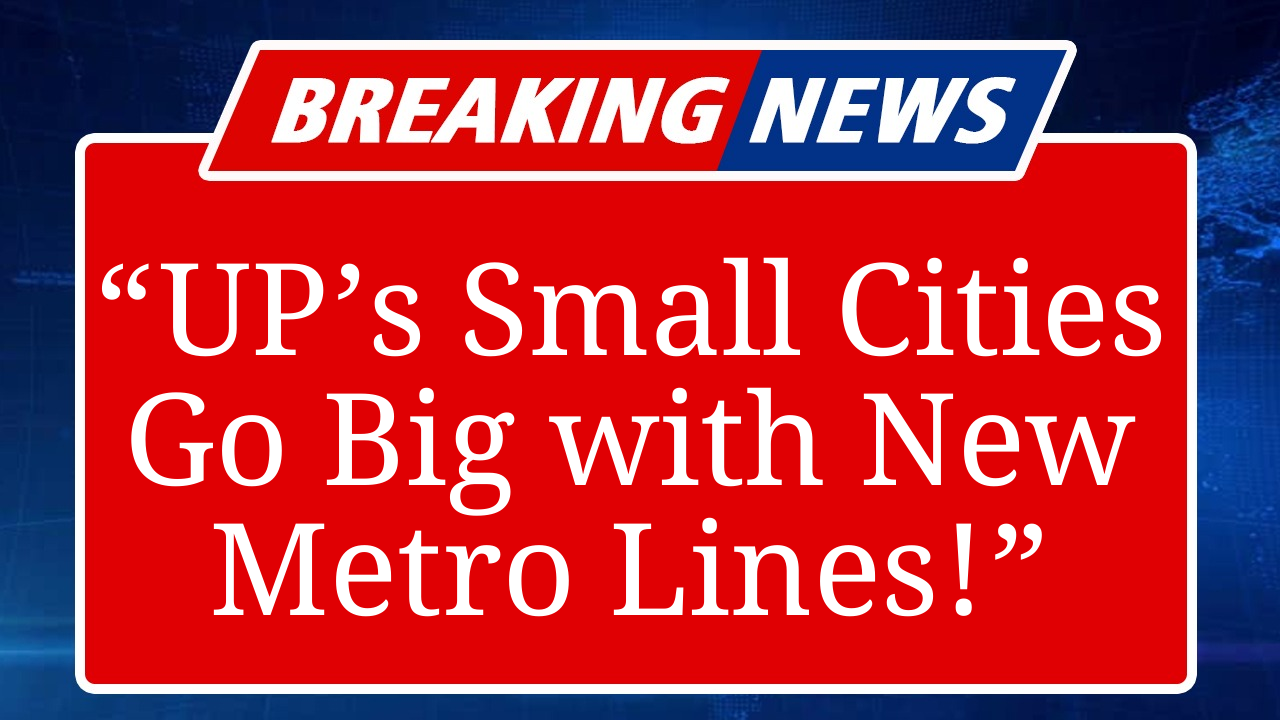“Uttar Pradesh is revolutionizing urban mobility with new metro lines in smaller cities like Agra, Kanpur, and Meerut, enhancing connectivity and boosting economic growth. These projects, part of India’s broader metro expansion, aim to ease traffic congestion and provide sustainable transport, with Agra’s metro being the smallest yet impactful at 5.2 km.”
Uttar Pradesh’s Metro Expansion: Small Cities, Big Impact
Uttar Pradesh is witnessing a transformative phase in urban transportation as metro rail projects extend beyond its major hubs to smaller cities like Agra, Kanpur, and Meerut. As of October 2024, Uttar Pradesh boasts four operational metro systems, tying with Maharashtra for the highest number in India. This rapid expansion aligns with the state’s push to address growing urbanization and traffic congestion, offering residents affordable and efficient commuting options.
Agra, known for the Taj Mahal, has emerged as a focal point of this metro revolution. The Agra Metro, the smallest in India with a 5.2 km operational length, began services in 2024. Despite its compact size, it connects key areas along the Delhi-Mathura Road, with nine elevated stations including Sarai, NHPC Chowk, and Escorts Mujesar. Haryana Chief Minister ML Khattar recently praised the project, stating it elevates the city’s connectivity with other National Capital Region (NCR) towns, fostering progress. The metro, 95% indigenously built, provides a sustainable transport solution, reducing reliance on private vehicles.
Kanpur’s metro network, operational since 2021, has also made significant strides. Its Orange Line, stretching from IIT Kanpur to Motijheel, covers 9 km with fares ranging from Rs 10 to Rs 30. A Blue Line is currently under construction, expected to further enhance connectivity by 2026. The Kanpur Metro, managed by the Uttar Pradesh Metro Rail Corporation (UPMRC), serves as a lifeline for the city’s industrial and educational hubs, with daily ridership steadily increasing.
Meerut’s metro system, integrated with the Delhi-Meerut Regional Rapid Transit System (RRTS), renamed Namo Bharat, is another milestone. Operational since 2024, it shares infrastructure with the RRTS, offering high-speed connectivity at 160 kmph. The 13-km Delhi-Ghaziabad-Meerut Namo Bharat Corridor, inaugurated by Prime Minister Narendra Modi, has bolstered intercity travel, with stations like Sahibabad and New Ashok Nagar easing commuter congestion. This project exemplifies Uttar Pradesh’s innovative approach to blending metro and rapid rail systems for smaller cities.
The state’s metro initiatives are part of India’s broader urban transit boom. As of January 2025, India’s metro network spans over 1,000 km across 23 cities, with Uttar Pradesh contributing significantly to this growth. The Union Ministry of Housing and Urban Affairs reports that metro construction has accelerated from 600 meters per month before 2014 to 6 km per month today. This expansion is driven by the 2017 Metro Rail Policy, which mandates cities with populations above two million to develop Comprehensive Mobility Plans (CMPs) for mass transit systems.
Smaller cities like Agra and Kanpur benefit immensely from these projects. Property prices near metro stations in Uttar Pradesh have risen by up to 25%, mirroring trends in Delhi NCR, where metro proximity boosts real estate value by 20-50%. The Agra Metro, for instance, has spurred economic activity around its stations, attracting businesses and developers. Similarly, Kanpur’s metro has reduced travel times, making industrial and commercial areas more accessible.
However, challenges persist. A 2023 study by the Indian Institute of Technology (IIT) Delhi noted that many Indian metro systems, including those in smaller cities, struggle to meet projected ridership. Kanpur’s metro, for example, achieves only 30-40% of its expected daily commuters. Experts attribute this to inadequate last-mile connectivity and a lack of integration with bus systems. In response, Uttar Pradesh authorities are planning feeder services and e-rickshaw networks to bridge this gap.
The environmental impact of these metro projects is another key focus. The Agra Metro, like its counterparts, is designed to reduce carbon emissions, aligning with India’s sustainability goals. The Delhi Metro, a model for Uttar Pradesh’s systems, received United Nations recognition for cutting emissions, and similar benefits are expected in smaller cities as metro usage grows.
Looking ahead, Uttar Pradesh aims to expand its metro footprint further. Proposals for metro systems in cities like Varanasi, Gorakhpur, and Prayagraj are under consideration, with feasibility studies ongoing. These projects, if approved, could add another 50-100 km to the state’s metro network by 2030, aligning with India’s goal of a 1,900 km operational metro network across 31 cities by 2029.
The state’s metro mania reflects a broader national trend of prioritizing urban mobility. With government backing, international funding from agencies like the Japan International Cooperation Agency (JICA), and public-private partnerships, Uttar Pradesh is positioning its smaller cities as hubs of connectivity and growth. As these metro lines expand, they promise to redefine urban life, making travel faster, greener, and more inclusive for millions.
Disclaimer: This article is based on recent news reports, government press releases, and industry analyses available as of September 2025. Information is sourced from credible platforms, including the Press Information Bureau, Metro Rail News, and Times of India. Readers are advised to verify details through official channels for the latest updates.

